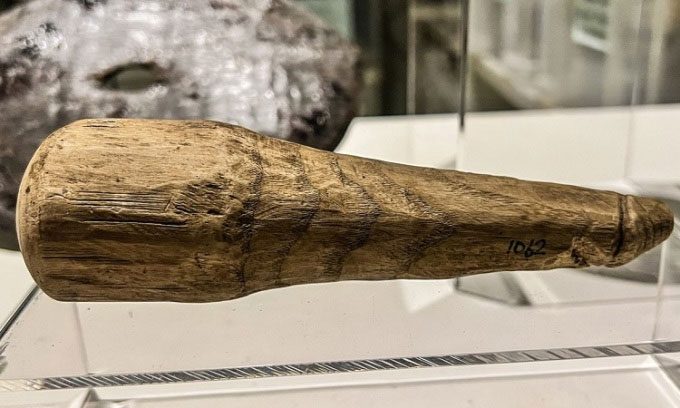A wooden artifact nearly 2,000 years old, measuring about 16 cm, may have served as a sex toy for the ancient Romans in Britain.
The artifact was excavated in 1992 from a drainage ditch at Vindolanda Roman Fort, located near Hadrian’s Wall in England, which marks the northwestern boundary of the Roman Empire. Archaeologists initially believed the object to be a sewing tool, according to research published in the journal Antiquity on February 19. This confusion arose because the tool was found alongside dozens of shoes and dress accessories, as well as various other small tools and craft debris.

Wooden artifact on display at the Vindolanda Museum. (Photo: Vindolanda Trust)
However, the research team speculates that the artifact is a phallus and describes several of its possible functions after careful examination. The carved item, measuring 160 mm, could have been used as a sex toy. If this is correct, it would be the only known example of a wooden phallus from Roman times, according to co-author of the study Rob Collins, a lecturer in archaeology at Newcastle University, UK. “We are not too surprised by this discovery. Through Roman literature and art, we know they used phallic objects, and they existed. But we have not previously found any archaeological examples,” Collins stated.
One reason such objects are not common in archaeology is that phallic items were often made from organic materials, which do not last long. According to the research team, the artifact could have been used by a slave owner to torture or demonstrate dominance and reinforce power.
Small phallic-shaped objects were often designed like pendants, possibly to ward off evil spirits or bad luck. However, the artifact in the study is carved from fresh ash wood, featuring a wide base and a pointed tip, with smoother sides tapering toward the middle. Therefore, it may have been placed on a statue or some structure for passersby to touch for good luck. This ritual was quite common throughout the Roman Empire. However, when comparing the object to similar wooden items from Egypt’s New Kingdom, researchers noted it lacks some necessary features to be placed on a structure.
Another possible use for the object is as a pestle for grinding or mixing cooking ingredients, producing cosmetics, ointments, or medicines. Symbolically, a phallic pestle could enhance the protective or effective properties of the ingredients. The artifact currently exhibited at the Vindolanda Museum could have served multiple purposes, or its function may have changed over time, according to Collins. Searching for similar examples in archaeology could help researchers more accurately determine the object’s function.





















































